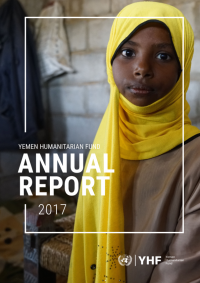Yemen Humanitarian Fund – Annual Report 2017
2017 IN REVIEW
HUMANITARIAN CONTEXT
A deepening humanitarian crisis
The year 2017 was marked by a steady deterioration of the humanitarian crisis in Yemen. The unabating conflict, the steady economic decline and the resulting collapse of basic social services further aggravated the vulnerability of millions of people whose coping mechanisms had been under pressure for two years. Displacement, food insecurity, disease and malnutrition continued to be the primary drivers of needs. As the year unfolded, a cholera outbreak, the worst recorded in history, spread across the entire country affecting more than one million people. By the end of the year the number of people in need had increased by 2 million, resulting in 20.8 million people requiring some form of humanitarian assistance and protection, 11.3 million of whom were in acute need.
Violations of IHL threaten the protection of civilians
The conduct of hostilities continued to be brutal, air strikes and fighting continued to inflict heavy casualties, damage public and private infrastructure, and impede delivery of humanitarian assistance. Serious concerns regarding the conduct of the conflict, in which all parties appeared to have committed violations of international humanitarian law and international human rights law continued to be raised. of 31 December 2017, health facilities had reported nearly reported 9,245 conflict related deaths and over 52,807 injuries. These figures significantly undercount the true extent of casualties given diminished reporting capacity of health facilities and people’s difficulties accessing healthcare. The conflict and violence engulfed the country in a vast protection crisis in which millions of people faced tremendous threats to their safety and wellbeing, and the most vulnerable struggled to survive.
Forced displacement and returns
Conflict continued to be the main driver of displacement. Since the escalation of the conflict in March 2015, more than 3 million people were displaced within Yemen, including 2 million who remained displaced by the end of 2017. While over 1 million former IDPs had provisionally returned to their areas of origin, the sustainability of these returns remained highly precarious due to lack of livelihoods opportunity, exhausted coping mechanism and crumbling access to social services in areas of return. Substantial numbers of returnees were found to be living in damaged houses, unable to afford repairs and facing serious protection risks. Nearly 70 per cent of returnees were in Aden, Sana’a or Taiz while half of the IDPs were sheltering in Hajjah, Taizz and Sana’a, living with host families or in rented accommodation.
Collapse of basic services and institutions
Essential basic services and the institutions that provide them continued to collapse under the weight of conflict, displacement and economic decline. As the public budget deficit grew by more than 50 per cent salaries for health facility staff, teachers and other public sector workers were paid erratically, often leaving 1.25 million state employees and their 6.9 million dependents – nearly 30 per cent of the population – without a regular income at a time of shortages and rising prices. The ability of public institutions to provide services contracted at a time while needs were surging. The inability of the health services to contain localized cases of cholera will result in the unfolding of an unprecedented outbreak.
Economic decline and access to markets
Economic decline and import restrictions continued to impact the availability and price of basic goods in markets.
Due to the intensification of the conflict, and restrictions of movement in active conflict areas, the formal market systems were disconnected and commodity movements were disrupted resulting in to scarcity and escalation of prices of essential food and non-food commodities. The closure of Yemen’s ports (sea, land and airports) on 6 November 2017 by the Saudi-led Coalition, resulted in the sharp rise within a 24 hours period in the prices for food, fuel and water had soared, putting them out of reach of vulnerable populations.
https://reliefweb.int/report/yemen/yemen-humanitarian-fund-annual-report-2017

